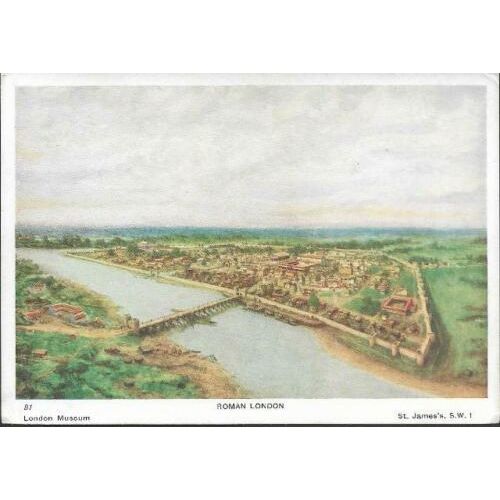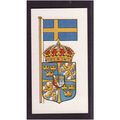London - artist impression of Roman London - Museum postcard c.1960s
- Condition : Used
- Dispatch : 2 Days
- Brand : None
- ID# : 190703073
- Quantity : 1 item
- Views : 159
- Location : United Kingdom

- Seller : justthebook (+1699)
- Barcode : None
- Start : Mon 06 Apr 2020 13:54:39 (BST)
- Close : Run Until Sold
- Remain : Run Until Sold
More Listings from This Seller view all
Seller's Description
- Postcard
- Picture / Image: Roman London [artist impression of London at this time]
- Publisher: London Museum, St. James's, SW1 [this was the forerunner of what is now the Museum of London in the City] - c.1960s
- Postally used: no
- Stamp: n/a
- Postmark(s): n/a
- Sent to: n/a
- Notes / condition: feels like printed on thicker better quality card than most postcards
- Postcard
Please ask if you need any other information and I will do the best I can to answer.
Image may be low res for illustrative purposes - if you need a higher definition image then please contact me and I may be able to send one. No cards have been trimmed (unless stated).
------------------------------------------------
Postage & Packing:
Postage and packing charge should be showing for your location (contact if not sure).
No additional charges for more than one postcard. You can buy as many postcards from me as you like and you will just pay the fee above once. Please wait for combined invoice. (If buying postcards with other things such as books, please contact or wait for invoice before paying).
Payment Methods:
UK - PayPal, Cheque (from UK bank) or postal order
Outside UK: PayPal ONLY (unless otherwise stated) please. NO non-UK currency checks or money orders (sorry).
NOTE: All postcards are sent in brand new stiffened envelopes which I have bought for the task. These are specially made to protect postcards and you may be able to re-use them. In addition there are other costs to sending so the above charge is not just for the stamp!
I will give a full refund if you are not fully satisfied with the postcard.
----------------------------------------------
Text from the free encyclopedia WIKIPEDIA may appear below to give a little background information (internal links may not work) :
*************
Londinium was a settlement established on the current site of the City of London around ad 43. Its bridge over the River Thames turned the city into a road nexus and major port, serving as a major commercial centre in Roman Britain until its abandonment during the 5th century.
Following its foundation in the mid-1st century, early Londinium occupied the relatively small area of 1.4 km2 (0.5 sq mi), roughly equivalent to the size of present-day Hyde Park, with a fortified garrison on one of its hills. In the year 60 or 61, the rebellion of the Iceni under Boudica forced the garrison to abandon the settlement, which was then razed. Following the defeat of Boudica by the Roman governor Gaius Suetonius Paulinus, the city was rebuilt as a planned Roman town and recovered within about a decade. During the later decades of the 1st century, Londinium expanded rapidly, becoming Great Britain's largest city. By the turn of the century, Londinium had grown to perhaps 30,000 or 60,000 people, almost certainly replacing Camulodunum (Colchester) as the provincial capital and by the mid-2nd century, Londinium was at its height. Its forum and basilica were one of the largest structures north of the Alps when the Emperor Hadrian visited Londinium in 122. Excavations have discovered evidence of a major fire that destroyed most of the city shortly thereafter, but the city was again rebuilt. By the second half of the 2nd century, Londinium appears to have shrunk in both size and population.
Although Londinium remained important for the rest of the Roman period, no further expansion resulted. Londinium supported a smaller but stable settlement population as archaeologists have found that much of the city after this date was covered in dark earth—the by-product of urban household waste, manure, ceramic tile, and non-farm debris of settlement occupation, which accumulated relatively undisturbed for centuries. Sometime between 190 and 225, the Romans built a defensive wall around the landward side of the city. Along with Hadrian's Wall and the road network, this wall was one of the largest construction projects carried out in Roman Britain. The London Wall survived for another 1,600 years and broadly defined the perimeter of the old City of London.
The etymology of the name Londinium is unknown. Following Geoffrey of Monmouth's pseudohistorical History of the Kings of Britain,[2][3] it was long derived from an eponymous founder named Lud, son of Heli. There is no evidence such a figure ever existed. Instead, the Latin name was probably based on a native Brittonic placename reconstructed as *Londinion.[5] Morphologically, this points to a structure of two suffixes: -in-jo-. However, the Roman Londinium was not the immediate source of English "London" (Old English: Lunden), as i-mutation would have caused the name to have been Lyndon. This suggests an alternative Brittonic form Londonion;[8] alternatively, the local pronunciation in British Latin may have changed the pronunciation of Londinium to Lundeiniu or Lundein, which would also have avoided i-mutation in Old English.[9] The list of the 28 Cities of Britain included in the 9th-century History of the Britons precisely notes London[10] in Old Welsh as Cair Lundem[11] or Lundein.[10][13]
The site guarded the Romans' bridgehead on the north bank of the Thames and a major road nexus. It centered on Cornhill and the River Walbrook, but expanded west to Ludgate Hill and east to Tower Hill. Just prior to the Roman conquest, the area had been contested by the Catuvellauni based to its west and the Trinovantes based to its east; it bordered the realm of the Cantiaci on the south bank of the Thames.
The Roman city ultimately covered at least the area of the City of London, whose boundaries are largely defined by its former wall. Londinium's waterfront on the Thames ran from around Ludgate Hill in the west to the present site of the Tower in the east, around 1.5 kilometres (0.93 mi). The northern wall reached Bishopsgate and Cripplegate near the Museum of London, a course now marked by the street "London Wall". Cemeteries and suburbs existed outside the city proper. A round temple has been located west of the city, although its dedication remains unclear. Substantial suburbs existed at St Martin-in-the-Fields in Westminster and around the southern end of the Thames bridge in Southwark, where inscriptions suggest a temple of Isis was located.[15]
Listing Information
| Listing Type | Gallery Listing |
| Listing ID# | 190703073 |
| Start Time | Mon 06 Apr 2020 13:54:39 (BST) |
| Close Time | Run Until Sold |
| Starting Bid | Fixed Price (no bidding) |
| Item Condition | Used |
| Bids | 0 |
| Views | 159 |
| Dispatch Time | 2 Days |
| Quantity | 1 |
| Location | United Kingdom |
| Auto Extend | No |




 for 1 item(s)
for 1 item(s)















